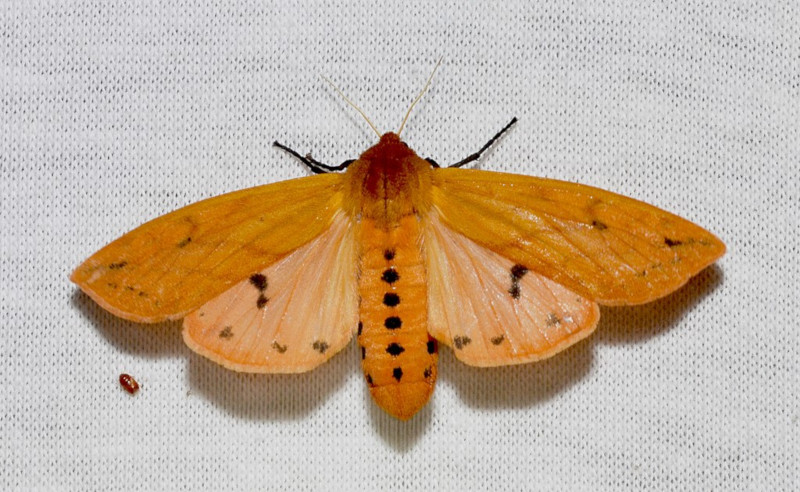Isabella Tiger Moth Facts
- Most notably, the term Isabella Tiger Moth serves as the much more pronounceable common name for this beauty. Its scientific name, however, is that of the hard to pronounce term of Pyrrharctia isabella. Thankfully, though, the insect has others.
- This beautiful Lepidoptera, in fact, goes by several other common names. These different names include the banded woolly bear, the woolly bear, and the woolly worm. By whatever term one calls it, though, it represents a truly magnificent specimen.
- The first scientific recognition of this deceptively ordinary-seeming remarkable species occurred in the year 1797. At that time, the description occurred as the result of work done by the well known English botanist Sir James Edward Smith.
- Quite interestingly, this small moth also holds a small surprise for those just learning of it. That’s because it holds a position of moderate importance in the folklore of certain parts of its native range. This fact alone earns it a place of importance.
- The belief maintains that the relative percentage of different colors in its fur each year predicts the relative severity of the coming winter. Finally, and quite fortunately, unlike many of its relatives, the Isabella Tiger Moth appears to still have a stable population.
- The IUCN, therefore, currently does not have any listing for this species on its Red List of Threatened Species. Habitat loss could threaten it soon, however. The ongoing and escalating effects of climate change could also pose a danger in the near future.
Related Articles
Isabella Tiger Moth Physical Description
Perhaps most notably of all, the gorgeous Isabella Tiger Moth, like many related creatures, displays a moderate degree of sexual dimorphism. In the case of this species, that shows itself in terms of coloration. This principle, in fact, appears in many species of moth.
The adult males of this incredible arthropod generally display a primarily pale orange color. Females, meanwhile, typically display a predominantly rosy color. In terms of physical size, though, the genders of this marvelous insect remain essentially identical.
The overall wingspan, however, does vary somewhat significantly, without apparent regard for gender. As a result, mature adults attain a wingspan ranging from about 1.77 – 2.56 in (4.5 – 6.5 cm). This trait also distinguishes it from most of its related species.
The larval form of this fascinating invertebrate, though remain its best known form. That holds true because of the extreme size these attain, at least compared to similar creatures. Other species, such as the Regal Moth, also display this surprising physical trait.
This part of its life cycle averages about 2.25 in (5.7 cm) in length. Generally, the larvae display a covering of dense fur. This stage of the Isabella Tiger Moth typically presents a reddish-brown fur in the middle of the body, and black on the front and back of the body.
- Kingdom: Animalia
- Phylum: Arthropoda
- Class: Insecta
- Order: Lepidoptera
- Family: Erebidae
- Genus: Pyrrharctia
- Species: P. isabella
Isabella Tiger Moth Distribution, Habitat, and Ecology
Quite fortunately, the wonderful Isabella Tiger Moth inhabits a comparatively broad range of the globe. More precisely, however, this zone of habitation consists of parts of North America. More specifically, it mainly appears throughout most the continental United States.
The insect also inhabits the southern portions of Canada, though. Scattered individuals also appear as far north as the Arctic region, however. The small but amazing invertebrate further displays a relatively high degree of adaptability in its choice of habitats.
It is this versatility that helps it survive in areas of extreme cold. That holds true due to the fact that it appears in virtually any area with sufficient vegetation. It nonetheless demonstrates a decided preference for various trees, grasses, and certain flowers.
The larval form of the Isabella Tiger Moth typically emerges from the eggs in the late Fall season. Then, the caterpillar stage spends the winter quiescent, literally freezing solid. It then survives the freezing process due to an amazing evolutionary adaptation.
This astounding development of evolution involves the production of a natural protective chemical that prevents destruction of its tissues during the freezing process. Upon emerging from this self-imposed stasis in the spring, the caterpillar feeds voraciously.
At that time, the arthropod eats virtually any plant it finds. Individuals nonetheless do seem to prefer various grasses, as well as the foliage of trees such as birches, elms, and maples. Adults, however, only feed on the nectar of different types of flowers.
Species Sharing Its Range
Check out our other articles on Madagascar’s Astounding Inhabitants, European Honey Buzzard , Borra Caves, Armored Sea Robin, Wax Currant, Iridescent Bark Mantis, Leaping Lesbian Lizard

